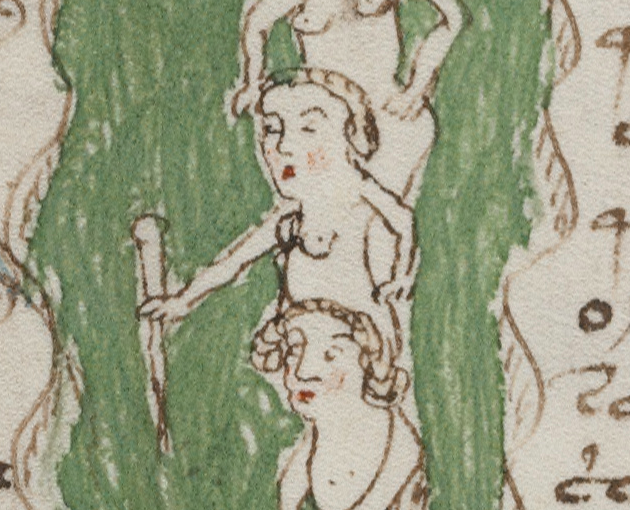Further to the inner workings of QOKEEDY - one of the two paradigmatic words that, I contend, underpin the Voynich text – we should not overlook the more obvious patterns.
Previous posts have underlined the importance, if not the primordiality, of the glyph [o]. In one of them I described the “Journey of [o]” when we read the glyphs of QOKEEDY as a sequence.
Here is another observation:
If we take the initial [o] in the paradigm as representing a WHOLE UNIT of some kind, then in the [ee] configuration it is HALVED and in the glyph [d] (conceivably) it is QUARTERED.
This requires us to see the [e] glyph as half an [o] glyph, and the [d] glyph as formed from two [o] glyphs, or four [e] glyphs.
These glyphs in QOKEEDY can be read as:
One
Two halves
Four quarters
It is a simple arithmetic or proportional sequence.
As for the final [y], it is an [o] with a back-turning tail, and to all appearances it signifies: RETURN. START AGAIN. Back to the whole unit.
* * *
There is no avoiding the suspicion that this phenomenon is perhaps musical in nature.
In that case, this study becomes a job for someone conversant in early Renaissance music, and systems of musical notation.
It is not my field, but from what little I know I think a question to ask would be: Is the [q] a maxima? And then we see its divisions?
Or is it too starkly arithmetic to be musical?
Like many others I have previously suggested the text might be musical, but in my case it is mainly on conceptual grounds. I see the text as being cast as the ‘Language of the Nymphs’ – communications between the celestial and terrestrial nymphs, as depicted in the manuscript. Such communications might well be musical, since nymphs – throughout folklore - sing. Nymphs don’t write tomes or conduct discourses: they sing. In context - by my account - it could be a sung text.
As I see it, the language of the celestial nymphs is a pure form based on QOKEEDY, whereas the terrestrial nymphs speak a vernacular or rustic tongue, based on CHOLDAIIN.
But the text is not a dialogue. It is not set out in distinct speeches. They don’t speak in turn. Rather, the two streams are blended together.
The musical form this suggests is called, I believe, a secular motet. Often this would consist of a voice in Latin with another voice singing vernacular, or it could be two vernacular languages sung together.
Be that as it may, the internal sequence of QOKEEDY outlined above strongly suggests the text might be musical to its core. Are the paradigms musical? Is the [o] a musical unit?
There are other possibilities, but a musical explanation – where [o] is a whole note, or a duration – suggests itself immediately.
* * *
Regardless, we see a sequence: one, half, quarter, if our reading of the glyphs in this quite literal way is acceptable.
Its arithemetic nature should remind us, anyway, that no less than three of the glyphs in our verbum potentiae, QOKEEDY, are, in fact, glyphs commonly found in medieval use (and still) for numerals: [q] = 4, [d] = 8 and [y] = 9. We should not be surprised if this keyword is in some way mathematical, just for that reason alone.
It is not a forced reading of the glyphs in that context. Here we have a keyword with three numerals in the glyphs (all obscured in EVA.) We might well look for other evidence of a numerical pattern in such a word.
This is a simple pattern. Take the [o] as a whole unit, and then follow its permutations through the rest of the word:
Whole. Halves. Quarters. And final [-y] is: The whole again.
What does it mean, and how much further does it extend? If the [o] is a quantity, or measure – a unit of what? – then what is the role of the [q] and the [k]?
In the sequence we might say, reasonably, that the [q] initiates while the gallows glyph causes a breach – a breach that causes the whole unit [o] to halve and halve again.
* * *
Notice, by the way, that our paradigm starts with the numeral 4 and culminates in the numeral 8 – if we take the final [–y] as an affix signalling the start of the new cycle.
The glyph [d] – the numeral 8 – is the culmination of the sequence. So the halving of the glyph [o] we have described goes from the glyph [q] to the glyph [d], that is from numeral 4 to numeral 8. thus:
4 o ee 8
* * *



No comments:
Post a Comment